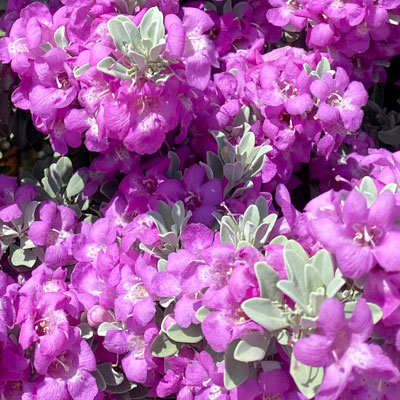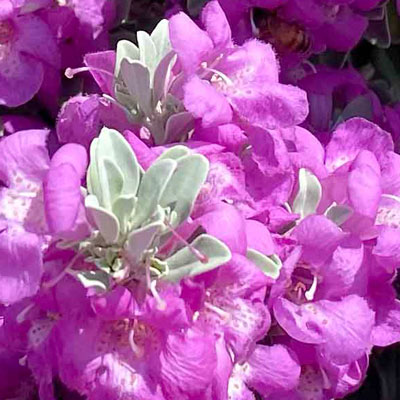Sage Advice

When it comes to native Texas shrubs, few are better known than this one. I guess yaupon holly would have to go at the top of the list. But as show-stopping, “I-gotta-have-one-of-those” shrubs, Texas sage leads the pack.
Why do we call it “Texas sage” anyway? It’s not related to salvias. That’s where we find the true sages. But botanists tell us that common names have no ground rules, so we can call it anything we want.
That would explain alternate names “silver leaf” (reasonable, considering its stunning silver foliage – at least for most varieties) and “barometer bush” (because it blooms after barometric pressure drops, as in rainy or humid weather. But I never heard anyone really use those last two common names.
The name I grew up using – the one I heard the ranchers using out on the hills in Southwest Texas – is “ceniza,” the Spanish word for “ash.”

Things to know about this plant…
Here are some basic botanical biographic facts you’ll want to remember.
• Names: Texas sage, or ceniza (Leucophyllum frutescens).
• Native range: Southwest Texas into adjacent parts of Mexico.
• Hardy to Zone 8 (10F). Suffers occasional to frequent freeze damage in DFW and northward.
• Full to nearly full sun. Does not do well in shade.
• Requires good drainage. Not suited to poorly draining soils.
• Handles alkaline soils perfectly.
• Grows to 6 to 8 feet tall and 5 to 6 feet wide. Compact forms are sold. Rather than sending you looking for specific variety names, it’s best to send you to a really good retail garden center and invite you to look at what they have on hand. Their Texas Certified Nursery Professionals will be able to guide you.
• Leaves are pubescent and silvery or gray, but green forms are sold.

• Flowers range from deep pink to pink to lavender to white.
• Will bloom several times over the course of a growing season, from late spring clear into fall. Flowers last only a few days.
• Extremely popular with bees!
• Looks best when only pruned to remove erratic branching. Avoid formal shearing. Major reshaping is best done in late winter.
• Few pest problems, although lace bugs can cause leaves to lose color, turn tan and sticky/shiny. Most general-purpose insecticides will control them, but spray at a time when plants are not blooming, therefore bees are not active around them.
